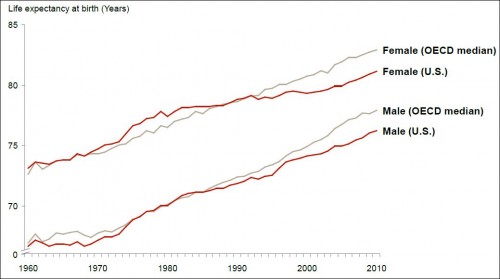What happened to US life expectancy? | The Incidental Economist.
Source: JAMA  study “The Anatomy of Health Care in the United Statesâ€
“Possible causes of this departure from international norms were highlighted in a 2013 Institute of Medicine report and have been ascribed to many factors, only some of which are attributed to medical care financing or delivery. These include differences in cultural norms that affect healthy behaviors (gun ownership, unprotected sex, drug use, seat belts), obesity, and risk of trauma. Others are directly or indirectly attributable to differences in care, such as delays in treatment due to lack of insurance and fragmentation of care between different physicians and hospitals. Some have also suggested that unfavorable US performance is explained by higher risk of iatrogenic disease, drug toxicity, hospital-acquired infection, and a cultural preference to “do more,†with a bias toward new technology, for which risks are understated and benefits are unknown. However, the breadth and consistency of the US underperformance across disease categories suggests that the United States pays a penalty for its extreme fragmentation, financial incentives that favor procedures over comprehensive longitudinal care, and absence of organizational strategy at the individual system level. [Link added.]”
“Relative to the OECD average, the U.S. spends an amount of money equal to $1.6 trillion a year extra on health care, and lags in life expectancy by 2 years. If we had kept pace in health spending, we would have $1.6 trillion extra to spend on useful things–and those things would have been worth $1.6 trillion a year. The value of longer life is harder to guesstimate. One way to approach the question would be to simply assert that we combine lifespan and health with goods and services to produce extra utility–say an extra $32 trillion a year of utility–and that with if we had 1/40 more time we would be able to get another $0.8 trillion a year of utility.
The total cost of underperformance would then be $2.4 trillion a year: 2/3 of that from resources we could devote to other useful things but are instead devoting to our extraordinarily inefficient health sector, and 1/3 from the fact that even with these extra resources our health outcomes are still very disappointing…”

